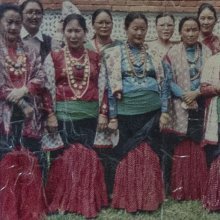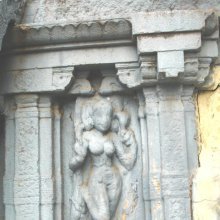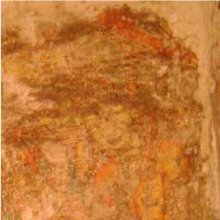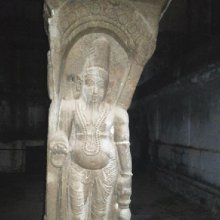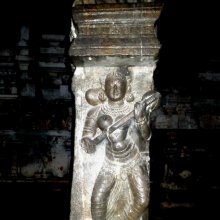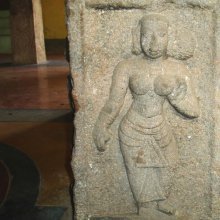Costume: 2 definitions
Introduction:
Costume means something in Hinduism, Sanskrit. If you want to know the exact meaning, history, etymology or English translation of this term then check out the descriptions on this page. Add your comment or reference to a book if you want to contribute to this summary article.
Images (photo gallery)
(+2 more images available)
In Hinduism
Natyashastra (theatrics and dramaturgy)
Source: Shodhganga: Elements of Art and Architecture in the Trtiyakhanda of the Visnudharmottarapurana (natya)Costume and Make-up (in Indian Dramas) are included in the division of Āhāryābhinaya: one of the four divisions of Abhinaya or “ways to convey or represent one’s emotion to others”, according to the Viṣṇudharmottarapurāṇa, an ancient Sanskrit text which (being encyclopedic in nature) deals with a variety of cultural topics such as arts, architecture, music, grammar and astronomy.—Costume and make up are the two important concerns of a Drama which transforms the actors according to their respective roles. In the Nāṭyaśāstra, Bharata advises to pay attention in costume and make-up for a healthy and successful dramatic production. Different kinds of dramatic characters are initially indicated by their attire and make up which represent them in front of the viewers without any effort.
According to the Viṣṇudharmottarapurāṇa, There are four kinds of costume and make up viz.,
- prasta,
- alaṃkāra,
- aṅgaracanā and
- sajjīva.
The colour of every costume of every character should be different, as discussed in the third part of the Viṣṇudharmottarapurāṇa. As for example, the costume of dhīrodātta type of hero is suggested as not to be very loud where as it suggests that the costume of king should be graceful. In the Nāṭyaśāstra also the dress of a king is suggested to be variegated in colour which definitely brings graceful look. On the other hand, the attire of the pratināyaka i.e., the villain, should be very gaudy and the costumes of rest of the characters should be according to the country and their professions. This part of Drama shows a wide range of options on the basis of various concerned sources.

Natyashastra (नाट्यशास्त्र, nāṭyaśāstra) refers to both the ancient Indian tradition (shastra) of performing arts, (natya—theatrics, drama, dance, music), as well as the name of a Sanskrit work dealing with these subjects. It also teaches the rules for composing Dramatic plays (nataka), construction and performance of Theater, and Poetic works (kavya).
Shilpashastra (iconography)
Source: Shodhganga: Elements of Art and Architecture in the Trtiyakhanda of the Visnudharmottarapurana (shilpa)Costumes and Accessories follows specific guidelines in the tradition of ancient Indian Painting (citra), according to the Viṣṇudharmottarapurāṇa, an ancient Sanskrit text which (being encyclopedic in nature) deals with a variety of cultural topics such as arts, architecture, music, grammar and astronomy.—In the Viṣṇudharmottarapurāṇa, the rules of Painting of different classes have been elaborately discussed. The costumes and accessories of different personalities in a picture are also described in the Viṣṇudharmottarapurāṇa. Different works of Sanskrit literature can offer a vast field of example in this regard. Though the references of costume and attires of different personalities found in the writings of different poets are not in the form of a portrait, but these descriptions supply a pen picture of the characters and it can create a definite form in the mind of the readers.

Shilpashastra (शिल्पशास्त्र, śilpaśāstra) represents the ancient Indian science (shastra) of creative arts (shilpa) such as sculpture, iconography and painting. Closely related to Vastushastra (architecture), they often share the same literature.
See also (Relevant definitions)
Full-text (+323): Aharyabhinaya, Bhesha, Bhumika, Aharya, Peharava, Libhasa, Nepattha, Nepathya, Natya, Pahirana, Nepathyabhrit, Pataikkolam, Abhinaya, Lavai, Ramper, Dress, Telangi, Jalali, Naipattiyam, Kapatavesha.
Relevant text
Search found 54 books and stories containing Costume; (plurals include: Costumes). You can also click to the full overview containing English textual excerpts. Below are direct links for the most relevant articles:
Cosmetics, Costumes and Ornaments in Ancient India (by Remadevi. O.)
1. Materials for Garments (Introduction) < [Chapter 2 - Costumes]
2.13. Costumes of Deities < [Chapter 2 - Costumes]
Puppetry in Assam (by Gitali Saikia)
Costume of puppets of Assam < [Chapter 4]
Types of puppetry practiced in Assam < [Chapter 4]
Chapter 5: Comparative Study Of Indian Puppet And Assam’s Puppet
Vishnudharmottara Purana (Art and Architecture) (by Bhagyashree Sarma)
1.3. Elements of Drama (b): Costume and Make up < [Chapter 3 - Drama and Dance]
1. The Viṣṇudharmottara-purāṇa and Modern Drama < [Chapter 6 - Modern Relevance of Different Art Forms and Architecture]
1.3. Elements of Drama (a): Acting < [Chapter 3 - Drama and Dance]
Kathakali < [October 1968]
The Modern Theatre and Ancient Tradition < [August 1937]
Similarities Between Bhavai And Folk Art Forms < [April – June, 1999]
Diaspora of Bhuta (Daiva) worshipping cult—India and Indonesia (by Shilpa V. Sonawane)
Part 7-8 - Jumadi (or Dhumavati) < [Chapter 1 - Introduction]
Introduction < [Chapter 1 - Introduction]
Part 2 - Duality and Symbolism in Balinese Performance Art < [Chapter 4 - Inter-Disciplinary Analysis]
The backdrop of the Srikanthacarita and the Mankhakosa (by Dhrubajit Sarma)
Part 2 - Dress and decoration (found in the Śrīkaṇṭhacarita) < [Chapter IV - Socio-cultural study of the Śrīkaṇṭhacarita]
Part 5 - Śrīkaṇṭhacarita - Summary of contents < [Chapter II - The Śrīkaṇṭhacarita]
